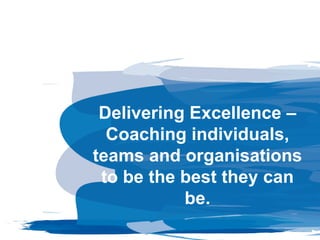Delivery Excellence
- 1. Delivering Excellence â Coaching individuals, teams and organisations to be the best they can be.
- 2. Step 1 Data analysis Hard data aligned to the purpose of the contract or desired outcome Form initial âopinionâ from data Step 2 Individual or organisational intelligence and local knowledge Share basis of opinion and overlay with local knowledge Identify and agree scope of work Step 3 Scope of work discussions Define and agree the scope of work detail Plan and agree timetable and resources - costs, etc, involved Step 4 Discovery Interviews and assessment Observation, interview and/or team session Test assumptions and form recommendations Step 5 Conclude and review Feedback findings and conclusions Agree recommendations and changes - SMART Action Plan Process: Planning, Analysis, and Recommendations
- 3. One to one interviews Group work Observations Resources Customer feedback Customer experience Purpose, outcome or result Recommendations Assessment Method: Multi-Source data gathering, focused on the customer experience, to generate specific actionable recommendations.
- 4. Comments will be categorised under the following headings to focus conclusion and summary in the correct area: Customer experience Leadership & MI Resources Targets & measures â aligned to outcomes Findings / Recommendations: Formal suggestions categorized by âAction Areaâ with specific tasks, measures, and expecting outcomes, target dates âĒ Current Performance âĒ Revenue âĒ Alignment âĒ Morale âĒ Contract âĒ Delivery Method âĒ Culture âĒ Knowledge of the landscape âĒ Contracted KPIâs âĒ Operations Alignment âĒ Testing âĒ Gap âĒ Plan âĒ LEAN, systems thinking, 6 sigma âĒ ÂĢHigh Value ROI âĒ Internal Staff, âĒ Multi Functional Teams âĒ MI and IT âĒ Setting a strategic Approach âĒ Developed a 4 stage incremental improvement Plan e.g. Base Camp 24%, 55%, 85% - 100% = The summit
- 5. Summary of findings, and action plan Why are we recommending this action? ï· Where the customer journey is clearly understood and implemented the performance is over 100%. ï· The customer journey should be consistent. ï· Differences working with a portfolio of contracts need to be clearly communicated and understood by front line staff. ï· Having a customer journey conducive to the sales outcomes of the service is critical to meet the contract. What evidence has resulted in this recommendation, based on the empirical evidence from 1:1 interviews, observations, team sessions, etc ? ï· âI tell my employees to stay away from Centre Driven Guidanceâ ï· âThe Centre is not performance driven all material is based around a Quality Systemâ (a quality system drives mediocrity) ï· From interviews, we did not get a sense of a defined customer journey apart from one delivery site, who were more structured in their approach to interviews, Information Advice and Guidance screening, management, planning when customers would increase sales and outcomes, and case conferencing, to optimise resources ï· The top performing site were confident and clear that their customer journey will incorporates actions that leads to most of their sales. ï· Regardless of how sales ready the customer are, we have no adequate way of ramping up activity proportionate to the amount of sales required or actions needed to improve outcomes T his is not an adequate amount of time for a customer who is ready to be promoted as a sale. A defined customer journey that needs to be consistent across all delivery and ALIGNED TO CONTRACTUAL OUTCOMES TO OPTIMISE PERFORMANCE
- 6. A defined the customer journey that needs to be consistent across all delivery and ALIGNED TO CONTRACTUAL OUTCOMES TO OPTIMISE PERFORMANCE What do we believe this will do to improve current contracted performance and continuously improve the business? ï· Following a consistent approach will ensure that The Business understand key performance indicators such as optimum on flow and off flow numbers and throughput. ï· Knowing the customer journey allows for continuous improvement from a Quality Perspective. It is difficult to monitor quality of provision when there is no consistent delivery model. ï· It will allow the organisation to retain their own expertise but ensure contracts are seen as the driver of their delivery model, from an outcome and sales point of view.





